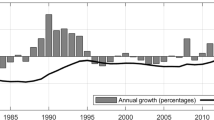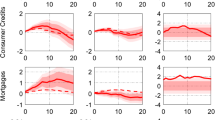Abstract
Unsurprisingly, a great deal of attention has been paid to the economic consequences of the credit crunch. However, this paper shows that the credit crunch was preceded by a strong build-up of mortgage debt internationally, which, in the long run, could turn out to be more significant than the credit crunch itself. Indeed, the debt build-up suggests that the credit crunch is more likely to reoccur, because highly-indebted households have weaker buffers to withstand unexpected shocks to their incomes or to interest rates. The paper presents a model that can explain the debt build-up and changes to the distribution of debt between existing owners and first-time buyers, which hinders access to home-ownership for the latter, even amongst those households who would be considered as credit-worthy.










Similar content being viewed by others
Notes
USA, Germany, France, Italy, UK, Austria, Belgium, Denmark, Spain, Finland, Ireland, Netherlands, Norway and Sweden. Data are taken from the OECD house price data base.
Since the published reference years for owner-occupation rates vary across countries, the debt/GDP ratios for the corresponding years are used.
However, these countries have paid greater attention to covered bonds in the fall-out from the credit crunch.
Although the initial establishment of the market dates back to the mid-80s.
For Australia, Reserve Bank estimates are used.
This holds on UK data. See, for example, Meen (2008).
Taken to be bank and building society deposits and national savings.
References
Akerlof, G. A., & Shiller, R. J. (2009). Animal spirits; how human psychology drives the economy and why it matters for global capitalism. Princeton: Princeton University Press.
Ball, M., Meen, G., & Nygaard, C. A. B. (2010). Housing supply revisited: Evidence from international, national, local and company data. Journal of Housing Economics, 19, 255–268.
Battellino, R. (2009). Housing and the economy. Remarks to the 6th National Housing Conference, Melbourne.
Canner, G. B., Passmore, W., & Mittal, M. (1994). Private mortgage insurance, federal mortgage insurance. October, 883–899.
Green, R., & Wachter, S. (2005). The American mortgage market in historical and international context. Journal of Economic Perspectives, 19(4), 93–114.
Greenspan, A., & Kennedy, J. (2005). Estimates of home mortgage originations, repayments, and debt on one-to-four-family residences. Finance and economics discussion series, federal reserve board, 41.
Krugman, P. (2008). The international finance multiplier. http://www.princeton.edu/~pkrugman/finmult.pdf.
Meen, G. P. (2001). Modelling spatial housing markets: Theory, analysis and policy. Boston: Kluwer Academic Publishers.
Meen, G. P. (2008). Ten new propositions in UK housing macroeconomics: An overview of the first years of the century. Urban Studies, 45(13), 2759–2781.
Muellbauer, J. (2005). Property taxation and the economy after the barker review. Economic Journal, 115(502), C99–C117.
Muellbauer, J., & Cameron, G. (2000). Five key council tax reforms and twelve reasons to enact them. New Economy, 7(2), 88–91.
Muellbauer, J., & Murphy, A. (1997). Booms and busts in the UK housing market. The Economic Journal, 107, 1701–1727.
Rajendra, G., & Påhlson-Möller, I. (2008). Australian residential mortgage-backed securities update. In Deutsche Bank Global Securitisation and Structured Finance.
Reinhart, C. M., & Rogoff, K. S. (2008). Is the 2007 U.S. sub-prime financial crisis so different? An international historical comparison. American Economic Review, 98(2), 339–344.
Reinhart, C. M., & Rogoff, K. S. (2009). This time is different: Eight centuries of financial folly. Princeton, New Jersey: Princeton Press.
Reinhart, C. M., & Rogoff, K. S. (2010). Growth in a time of debt. American Economic Review, 100(2), 573–578.
Stephens, M. (2000). Convergence in European mortgage systems before and after EMU. Journal of Housing and the Built Environment, 15(1), 29–52.
Tatch, J. (2006). Will the real first-time buyers please stand up? CML Housing Finance. London.
Author information
Authors and Affiliations
Corresponding author
Rights and permissions
About this article
Cite this article
Meen, G. The economic consequences of mortgage debt. J Hous and the Built Environ 26, 263–276 (2011). https://doi.org/10.1007/s10901-011-9225-x
Received:
Accepted:
Published:
Issue Date:
DOI: https://doi.org/10.1007/s10901-011-9225-x




